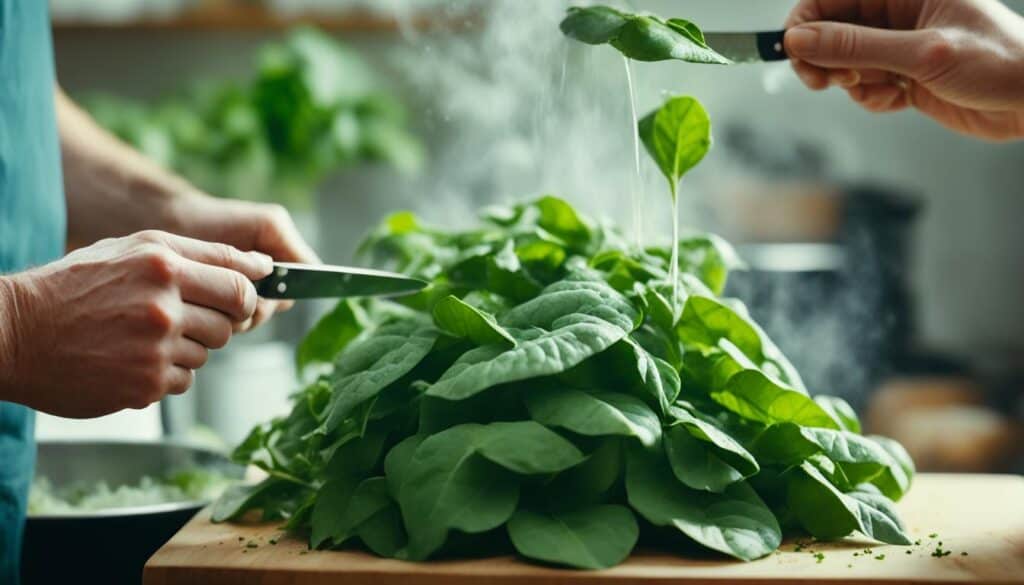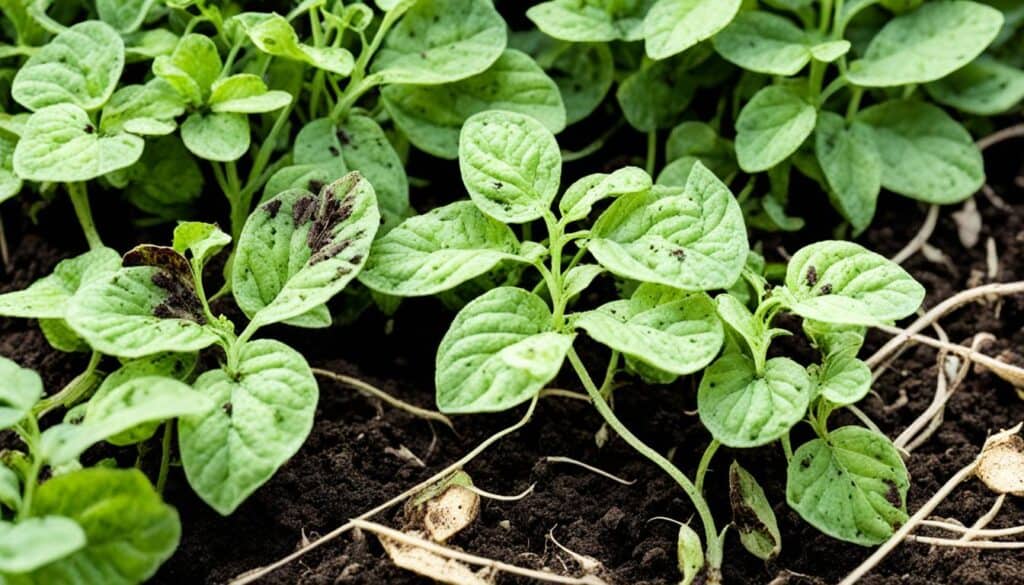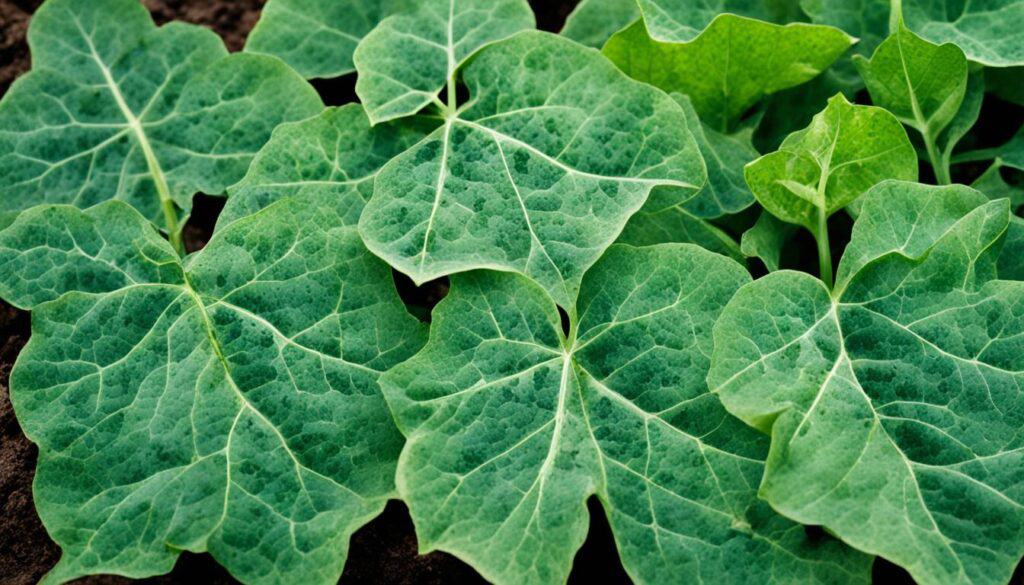Did you know that potato leaves are not only edible but also highly nutritious? These often overlooked leaves are packed with vitamins, minerals, and antioxidants that offer several potential health benefits. In addition, potato leaves can be used in various dishes and preparations, making them a versatile and valuable green to include in your diet.
Key Takeaways:
- Potato leaves are highly nutritious and offer several potential health benefits.
- They are packed with vitamins, minerals, and antioxidants.
- Potato leaves can boost immunity, promote healthy digestion, lower cholesterol levels, and more.
- They can be cooked in various ways and used in a variety of dishes.
- While generally safe to consume, some precautions should be taken, and consulting a healthcare professional is recommended.
Nutritional Value of Sweet Potato Leaves
When it comes to nutrition, sweet potato leaves are a powerhouse. Just 100 grams of steamed sweet potato leaves offer a wide range of essential vitamins and minerals, making them a valuable addition to your diet. Let’s take a closer look at the nutritional value of these leafy greens:
| Nutrient | Amount per 100g |
|---|---|
| Calories | 43 |
| Carbohydrates | 8 grams |
| Protein | 4 grams |
| Fat | 0 grams |
| Fiber | 3 grams |
| Vitamin A | 900 micrograms |
| Vitamin K | 600 micrograms |
| Vitamin C | 40 milligrams |
| Magnesium | 77 milligrams |
| Potassium | 600 milligrams |
| Folate | 45 micrograms |
| Iron | 2.5 milligrams |
In addition to these essential nutrients, sweet potato leaves also contain chlorophyll and antioxidants that offer additional health benefits. The combination of vitamins, minerals, fiber, and antioxidants makes sweet potato leaves a nutritious choice for promoting overall health and well-being.
Boosting Your Vitamin Intake
One of the standout features of sweet potato leaves is their impressive vitamin content. They are particularly rich in:
- Vitamin A: Sweet potato leaves are a fantastic source of beta-carotene, a type of vitamin A that plays a crucial role in maintaining healthy vision, boosting immune function, and promoting skin health.
- Vitamin K: Sweet potato leaves are loaded with vitamin K, which is important for blood clotting, bone health, and maintaining a healthy cardiovascular system.
- Vitamin C: These leaves also provide a significant amount of vitamin C, a powerful antioxidant that supports immune function, promotes collagen production, and helps protect against damage from harmful free radicals.
By including sweet potato leaves in your meals, you can easily boost your daily intake of these essential vitamins.
Benefits of Sweet Potato Leaves
Sweet potato leaves offer a plethora of health benefits, making them a valuable addition to your diet. These nutrient-packed greens can enhance your overall well-being and contribute to a healthy lifestyle.
Boosted Immunity
The high levels of vitamins and minerals in sweet potato leaves can help strengthen your immune system. These greens are rich in vitamin C, which is known for its immune-boosting properties. By incorporating sweet potato leaves into your meals, you can support your body’s natural defense mechanisms.
Promote Healthy Digestion
The fiber content in sweet potato leaves aids in promoting a healthy digestive system. Fiber helps regulate bowel movements, prevents constipation, and supports the growth of beneficial gut bacteria. Including sweet potato leaves in your diet can encourage proper digestion and overall gastrointestinal health.
Lower Cholesterol Levels
Research suggests that consuming sweet potato leaves may help lower cholesterol levels. These greens contain compounds that can help reduce LDL (bad) cholesterol levels and improve overall heart health. Adding sweet potato leaves to your meals can be a delicious way to support a healthy cardiovascular system.
Regulated Blood Sugar
For individuals managing diabetes or trying to balance their blood sugar levels, sweet potato leaves can serve as a valuable addition to their diet. These greens have a low glycemic index, meaning they have a minimal impact on blood sugar levels. Including sweet potato leaves in your meals can help regulate blood glucose levels and promote overall metabolic health.
Reduced Inflammation
Sweet potato leaves contain antioxidants and anti-inflammatory compounds that can help reduce inflammation in the body. Chronic inflammation is associated with various health conditions such as heart disease, arthritis, and diabetes. By incorporating sweet potato leaves into your meals, you can potentially lower inflammation levels and support overall well-being.
Promote Eye Health
The high levels of vitamin A in sweet potato leaves contribute to promoting eye health. Vitamin A is essential for maintaining good vision, preventing night blindness, and supporting overall eye health. Including sweet potato leaves in your diet can provide the necessary nutrients for optimal eye function.
Overall, the numerous benefits of sweet potato leaves, including immunity boost, digestive support, cholesterol reduction, blood sugar regulation, inflammation reduction, and eye health promotion, make them an excellent addition to a nutritious diet.
Culinary Uses of Sweet Potato Leaves
When it comes to cooking sweet potato leaves, the possibilities are endless. These versatile greens can be incorporated into a variety of dishes to add a nutritious and flavorful twist. From sautéing to boiling, steaming to baking, there are numerous ways to enjoy the culinary benefits of sweet potato leaves.
Sautéed Sweet Potato Leaves
One popular method of preparing sweet potato leaves is sautéing. Heat a little oil in a pan and add the leaves, tossing them until they’re wilted and tender. You can season them with salt, pepper, and your favorite herbs or spices to enhance the flavor. Sautéed sweet potato leaves make a delicious side dish and pair well with various cuisines.
Boiled or Steamed Sweet Potato Leaves
Another simple way to cook sweet potato leaves is by boiling or steaming them. This method helps retain their vibrant green color and delicate texture. Boil them in salted water until tender, or steam them for a few minutes until they wilt. Once cooked, sweet potato leaves can be used in soups, stir-fries, or salads.
Baked Sweet Potato Leaves
If you prefer a crispy texture, baking sweet potato leaves is an excellent option. Toss the leaves in olive oil, sprinkle with some salt and pepper, and spread them out on a baking sheet. Bake in a preheated oven at 350°F for about 10-15 minutes until they turn crispy. Baked sweet potato leaves make a great alternative to potato chips or kale chips.
Sweet Potato Leaf Salad
If you enjoy raw greens, sweet potato leaves can be enjoyed in salads. However, they have a slightly bitter taste, which can be mellowed out through cooking. If you still want to eat them raw, consider combining them with other greens and adding complementary flavors like citrus fruits, nuts, and dressings to balance out the bitterness.
Recipe Inspiration
“Try this delicious recipe for a Sweet Potato Leaf Stir-Fry:
Ingredients:
– 2 cups sweet potato leaves, washed and chopped
– 1 tablespoon cooking oil
– 2 cloves garlic, minced
– 1 teaspoon soy sauce
– 1/2 teaspoon sesame oil
– Salt and pepper to tasteInstructions:
1. Heat the cooking oil in a pan or wok over medium heat.
2. Add the minced garlic and stir-fry until fragrant.
3. Add the sweet potato leaves and stir-fry until wilted and tender.
4. Drizzle with soy sauce and sesame oil, and season with salt and pepper.
5. Stir-fry for another minute or until well combined.
6. Serve hot as a side dish with rice or noodles.”
Feel free to experiment with different cooking methods and explore the flavors and textures of sweet potato leaves. With their incredible nutritional profile and versatility, these greens are a fantastic addition to your culinary repertoire.
| Benefits of Cooking Sweet Potato Leaves: | Recipes with Sweet Potato Leaves: | Eating Sweet Potato Leaves Raw: |
|---|---|---|
| – Enhances the flavor profile of dishes | – Sweet Potato Leaf Stir-Fry | – Can be enjoyed in salads |
| – Softens the bitter taste | – Sweet Potato Leaf Soup | – Pair with other greens and complementary flavors |
| – Retains the vibrant green color | – Baked Sweet Potato Leaf Chips | |
| – Offers a variety of textures |
How to Identify and Address Potato Leaf Problems
Sweet potato leaves, like any other plant, can be susceptible to various pests, diseases, and problems. Common issues include potato leaf curl, yellowing, spots, and blight. It is important to identify these problems early and take appropriate measures to address them. This may involve using organic or chemical treatments, adjusting environmental conditions, or implementing cultural practices to prevent further damage.
Causes and Symptoms of Potato Leaf Problems
There are several factors that can contribute to potato leaf problems. These include:
- Potato leaf diseases, such as potato leaf blight or potato leaf curl virus
- Potato leaf pests, including aphids, mites, or beetles
- Poor soil conditions, nutrient deficiencies, or overwatering
- Inconsistent or extreme temperatures
- Excessive exposure to sunlight or inadequate shade
To identify potato leaf problems, closely examine the leaves for any visible signs of damage or discoloration. Look for:
- Leaf curling or wrinkling
- Yellowing or browning of the leaves
- Spots or lesions on the leaves
- Wilting or drooping foliage
Addressing Potato Leaf Problems
Once potato leaf problems are identified, it is essential to take prompt action to minimize further damage. Here are some effective strategies to address potato leaf problems:
- Organic treatments: Use natural remedies such as neem oil, insecticidal soap, or homemade sprays to control pests and diseases.
- Chemical treatments: If the infestation or disease is severe, consider using chemical pesticides or fungicides. Remember to follow the instructions carefully and handle chemicals safely.
- Environmental adjustments: Modify watering schedules, improve drainage, and provide adequate shade or protection to create optimal growing conditions for sweet potato leaves.
- Cultural practices: Implement practices such as crop rotation, proper fertilization, and regular pruning to prevent or manage potato leaf problems.
“Early detection and timely intervention are crucial in preventing the spread of potato leaf diseases and pests.”
| Potato Leaf Problem | Symptoms | Treatment |
|---|---|---|
| Potato Leaf Curl | Leaves curl upwards or become distorted | Remove infected leaves and use insecticides |
| Potato Leaf Yellowing | Leaves turn yellow and may wilt | Adjust watering, provide nutrients, or treat for pests |
| Potato Leaf Spots | Dark or brown spots on leaves | Prune affected leaves, apply fungicides, or improve air circulation |
| Potato Leaf Blight | Brown spots with concentric rings on leaves | Remove infected leaves, use fungicides, and practice crop rotation |
Safety Precautions and Side Effects of Sweet Potato Leaves
While sweet potato leaves are generally safe to consume, it’s important to be aware of certain precautions and potential side effects. Here is what you need to know:
Possible Side Effects
Sweet potato leaves can cause digestive issues in some individuals, such as diarrhea or stomach cramps. If you experience any discomfort after consuming sweet potato leaves, it’s best to limit or avoid their consumption.
Oxalates and Kidney Health
It’s worth noting that sweet potato leaves contain oxalates, which can potentially lead to the formation of kidney stones or exacerbate existing kidney stone problems in individuals with a history of kidney stones or calcium-related disorders. If you have any concerns about your kidney health, it’s advisable to consult a healthcare professional before incorporating sweet potato leaves into your diet.
Medication Interactions
Additionally, sweet potato leaves may interact with certain medications, especially blood thinners. If you are taking any medications, it’s important to discuss the consumption of sweet potato leaves with your healthcare provider to ensure it is safe for you.
By being aware of these potential side effects and taking necessary precautions, you can enjoy the benefits of sweet potato leaves while minimizing any risks to your health.
| Precautions when consuming sweet potato leaves | Risks of sweet potato leaves |
|---|---|
| Limit or avoid consumption if experiencing digestive issues | Potential kidney stone formation |
| Consult a healthcare professional if you have kidney stone history or calcium-related disorders | Possible interactions with blood thinners |
Cultivating and Growing Sweet Potato Leaves
If you’re interested in growing your own supply of nutritious and delicious sweet potato leaves, you’ll be pleased to know that it is a relatively simple and rewarding process. By providing the right growing conditions, you can cultivate sweet potato plants that will produce abundant, healthy leaves throughout the growing season.
Choosing the Right Climate and Season
Sweet potato plants thrive in a frost-free climate, making them suitable for cultivation in various regions. Depending on your location, you can grow sweet potato leaves year-round or during specific seasons. It’s important to consider the temperature and frost patterns in your area to ensure successful growth.
Preparing the Soil
Start by choosing a well-drained soil that is rich in organic matter. Sweet potato plants prefer loose, sandy soil with a slightly acidic pH level (around 5.8 to 6.2). If your soil is heavy or clay-like, consider adding compost or organic matter to improve its drainage and fertility.
Planting Sweet Potato Slips
Sweet potato plants are typically grown from slips, which are small rooted cuttings taken from mature sweet potato tubers. These slips can be purchased from nurseries or sprouted at home. To plant sweet potato slips:
- Choose healthy slips with several leaves and a well-developed root system.
- Prepare a planting bed or container with loose, well-drained soil.
- Make small holes in the soil, spaced about 12-18 inches apart.
- Place the slips in the holes and gently cover the roots with soil, leaving the leaves exposed.
- Water the soil thoroughly after planting.
Providing the Right Growing Conditions
Sweet potato plants require adequate sunlight to thrive. Choose a location that receives at least 6-8 hours of direct sunlight daily. Regular watering is also essential. Keep the soil moist but not waterlogged to prevent root rot. Mulching can help retain soil moisture and prevent weed growth.
Harvesting Sweet Potato Leaves
Sweet potato leaves can be harvested multiple times throughout the growing season. As the plants grow, you can selectively pick the mature leaves while allowing the younger leaves to continue growing. Harvest by gently plucking the leaves from the stem.
Types of Sweet Potato Leaves
| Leaf Variety | Leaf Description |
|---|---|
| Green Sweet Potato Leaves | Smooth, vibrant green leaves with a mild flavor. |
| Purple Sweet Potato Leaves | Deep purple-colored leaves with an earthy, slightly sweet taste. |
| Red Sweet Potato Leaves | Bright red leaves with a slightly peppery flavor. |
With proper care and attention, you can enjoy a bountiful supply of sweet potato leaves right from your own garden. Not only will you have a fresh and nutritious addition to your meals, but you’ll also experience the joy of growing your own food. Happy gardening!
Where to Find Sweet Potato Leaves
Sweet potato leaves are a nutritious addition to any diet, but they may not be as readily available as other leafy greens in certain regions. However, there are still several places where you can find fresh sweet potato leaves to enjoy.
- Local Asian or African markets: These specialty markets often carry a wide variety of fresh produce, including sweet potato leaves. They may be sold as individual leaves or in bunches, depending on the market.
- Specialty grocery stores: Some larger grocery chains or health food stores may have a section dedicated to international produce where you can find sweet potato leaves.
- Farmers’ markets: During the growing season, farmers’ markets are excellent places to find locally grown sweet potato leaves. You can directly support local farmers while ensuring the freshness of the produce.
If you prefer a more hands-on approach, you can also consider growing sweet potato plants in your own garden. This way, you can have a steady supply of fresh sweet potato leaves whenever you want.
Whether you choose to purchase sweet potato leaves or grow them yourself, they are a flavorful and nutrient-rich addition to your meals.
Conclusion
In conclusion, sweet potato leaves are both nutritious and versatile, offering a wide range of health benefits. Packed with essential vitamins, minerals, antioxidants, and fiber, they make a valuable addition to any healthy diet. Whether you prefer them cooked or raw, sweet potato leaves can be enjoyed in various culinary preparations, from stir-fries and salads to soups and smoothies.
However, it is crucial to be aware of potential side effects and take necessary precautions. Some individuals may experience digestive issues after consuming sweet potato leaves, while others with specific health conditions or medications may need to exercise caution. Consulting a healthcare professional is recommended if you have any concerns or questions.
Overall, incorporating sweet potato leaves into your diet can contribute to a well-rounded and nutritious eating plan. Their numerous health benefits, including immune support, healthy digestion, cholesterol regulation, and cardiovascular support, make them a valuable addition to your meals. So, why not give these nutritious and versatile greens a try and experience the benefits for yourself?









Leave a Reply